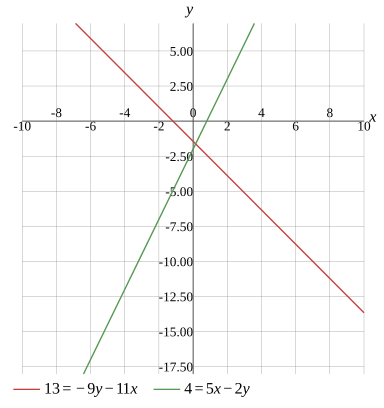Question
Solve the system of equations
Solve using the substitution method
Solve using the elimination method
Solve using the Gauss-Jordan method
Load more

(x,y)=(6710,−67109)
Alternative Form
(x,y)≈(0.149254,−1.626866)
Evaluate
{13=−9y−11x4=5x−2y
Solve the equation for x
More Steps


Evaluate
13=−9y−11x
Swap the sides of the equation
−9y−11x=13
Move the expression to the right-hand side and change its sign
−11x=13+9y
Change the signs on both sides of the equation
11x=−13−9y
Divide both sides
1111x=11−13−9y
Divide the numbers
x=11−13−9y
Use b−a=−ba=−ba to rewrite the fraction
x=−1113+9y
{x=−1113+9y4=5x−2y
Substitute the given value of x into the equation 4=5x−2y
4=5(−1113+9y)−2y
Multiply the terms
More Steps


Evaluate
5(−1113+9y)−2y
Multiply the terms
More Steps


Evaluate
5(−1113+9y)
Multiplying or dividing an odd number of negative terms equals a negative
−5×1113+9y
Multiply the terms
−115(13+9y)
−115(13+9y)−2y
4=−115(13+9y)−2y
Swap the sides of the equation
−115(13+9y)−2y=4
Multiply both sides of the equation by LCD
(−115(13+9y)−2y)×11=4×11
Simplify the equation
More Steps


Evaluate
(−115(13+9y)−2y)×11
Apply the distributive property
−115(13+9y)×11−2y×11
Simplify
−5(13+9y)−2y×11
Multiply the numbers
−5(13+9y)−22y
Expand the expression
More Steps


Calculate
−5(13+9y)
Apply the distributive property
−5×13−5×9y
Multiply the numbers
−65−5×9y
Multiply the numbers
−65−45y
−65−45y−22y
Subtract the terms
More Steps


Evaluate
−45y−22y
Collect like terms by calculating the sum or difference of their coefficients
(−45−22)y
Subtract the numbers
−67y
−65−67y
−65−67y=4×11
Simplify the equation
−65−67y=44
Move the constant to the right side
−67y=44+65
Add the numbers
−67y=109
Change the signs on both sides of the equation
67y=−109
Divide both sides
6767y=67−109
Divide the numbers
y=67−109
Use b−a=−ba=−ba to rewrite the fraction
y=−67109
Substitute the given value of y into the equation x=−1113+9y
x=−1113+9(−67109)
Simplify the expression
x=11−13+9×67109
Calculate
x=6710
Calculate
{x=6710y=−67109
Check the solution
More Steps


Check the solution
{13=−9(−67109)−11×67104=5×6710−2(−67109)
Simplify
{13=134=4
Evaluate
true
{x=6710y=−67109
Solution
(x,y)=(6710,−67109)
Alternative Form
(x,y)≈(0.149254,−1.626866)
Show Solution

Relationship between lines
Neither parallel nor perpendicular
Evaluate
13=−9y−11x,4=5x−2y
Write the equation in slope-intercept form
More Steps


Evaluate
13=−9y−11x
Move the expression to the left side
13+9y=−11x
Move the constant to the right side
9y=−11x−13
Divide both sides
y=−911x−913
y=−911x−913,4=5x−2y
Write the equation in slope-intercept form
More Steps


Evaluate
4=5x−2y
Move the expression to the left side
4+2y=5x
Move the constant to the right side
2y=5x−4
Divide both sides
y=25x−2
y=−911x−913,y=25x−2
Since the line is in slope-intercept form, the coefficient −911 is the slope of the line
−911,y=25x−2
Since the line is in slope-intercept form, the coefficient 25 is the slope of the line
−911,25
The slopes are different, so the lines aren't parallel. We'll multiply the slopes to check their relationship
−911×25
To multiply the fractions,multiply the numerators and denominators separately
−9×211×5
Multiply the numbers
−9×255
Multiply the numbers
−1855
Solution
Neither parallel nor perpendicular
Show Solution

Graph
